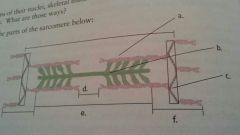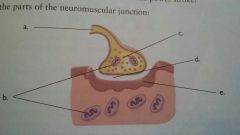![]()
![]()
![]()
Use LEFT and RIGHT arrow keys to navigate between flashcards;
Use UP and DOWN arrow keys to flip the card;
H to show hint;
A reads text to speech;
32 Cards in this Set
- Front
- Back
|
Sarcomere |
The repeating unit of a myofibril. |
|
|
Neuron |
The functional unit of the nervous system, a nerve cell. |
|
|
Synapse |
The interface between a neuron and another cell. |
|
|
Neurotransmitter |
A chemical released by a neuron. This chemical travels across the synaptic cleft, allowing the neuron to communicate with another cell. |
|
|
Motor Unit |
One Motor neuron and all the muscle fibers it innervates. |
|
|
All - Or - None law of Skeletal Muscle Contraction |
And individual muscle fiber contracts with maximum force in response to an action potential. |
|
|
Subthreshold Stimulus |
A stimulus too small to create an action potential in a neuron. |
|
|
Threshold Stimulus |
A stimulus strong enough to create one action potential in a neuron. |
|
|
Submaximal Stimulus |
Stimuli of increasing strength that create more action potentials in more motor neurons. |
|
|
Maximal Stimulus |
A stimulus that is strong enough to create action potentials in all the motor neurons innervating a whole muscle. |
|
|
Muscle Tone |
The state of partial contraction in a muscle, even when the muscle is not being used. |
|
|
What are the four major functional characteristics of muscle tissue? |
Contractility, excitability, extensibility, and elasticity. |
|
|
What are the three types of muscle tissue? |
Skeletal, smooth, and cardiac. |
|

Whole Muscle. |
A) Epimysium B) Perimysium C) Endomysium D) Myofibril E) Fascicle |
|
|
In terms of nuclei, skeletal muscle fibers are different from most cells in two ways. What are those ways? |
They have many nuclei and they are at the edge of the cell. |
|

Sacromere. |
A) Actin Myofilament B) Myosin Myofilament C) Z Disk D) H Zone E) A Band F) I Band |
|
|
When I muscle fiber contracts. What happens to: A) the distance between the Z Disks? B) the length of the A Band? C) the length of the I Bands? D) the length of the H Zone? E) the length of the Myosin Myofilament? F) the length of the Actin Myofilament? |
A) it decreases. B) it remains the same. C) it decreases. D) it decreases. E) it remains the same. F) it remains the same. |
|
|
The following stop Sakura for muscle contraction. Put them in proper order: A) the muscle action potential travels down the T - tubule. B) ACh is released from the presynaptic terminal. C) ATP bonds tho the Myosin heads, making them release to the active sides on the Actin. D) Ca^2+ binds to troponin, causing tropomyosin to move and exposing the active sides on the Actin, allowing the myosin heads to bind the Actin. E) ACh travels across the Synaptic cleft. F) the return stroke. G) Ca^2+ are released from the Sacroplasmic reticulum. H) the power stroke. I) an action potential travels down the axon of a motor nueron. J) ACh interacts with the muscle fiber membrane to create a muscle action potential. |
I, B, E, J, A, G, D, H, C, F. |
|
|
The concentration of Ca^2+ in the sacroplasmic reticulum is decreasing. Is the muscle fiber starting to contractor or has it finished contracting? |
Starting to contract. |
|
|
The Myosin heads of a sacromere have just received a boost of energy. Is the power stroke or the return stroke about to happen? |
Return stroke. |
|
|
A Myosin head has ADP attached to it but not an individual phosphate. Which is going to happen next: the return stroke or the power stroke? |
Power stroke. |
|

Nueromuscular Joint. |
A) Presynaptic Terminal B) Mitochondria C) Synaptic Vesicle D) Synaptic Cleft E) Postsynaptic Membrane |
|
|
If you could look at several muscle fibers while they were in action, how could you determine which fibers are part of the same motor unit? |
All of the fibers in the same motor unit will contract identically at the same time. |
|
|
What is the function of acetylcholinesterase? If it were not for acetylcholinesterase, what would happen to a muscle fiber? |
It inactivates ACh after ACh stimulated the Postsynaptic membrane. If it were not for this enzyme, the muscle fiber could not relax once it started contracting. |
|
|
There to major rolls that ATP plays in Muscle contraction and relaxation. The first involves a Sacroplasmic reticulum, while the second involves the Myosin head. What are these two roles? |
It provides the Sacroplasmic reticulum with Energy for the active transport of calcium ions into itself. It attaches to the Myosin heads, making them release the active sites and giving them Energy for the return stroke. |
|
|
A muscle is stiff. It can neither contract nor relax. What is wrong in the sacromere? What causes this? |
The Myosin heads must be gripping the active sites and not letting go. This must be due to the lack of ATP in the sacromere. |
|
|
When a muscle fiber relaxes, does it automatically stretch back to its resting size? |
No. |
|
|
A motor unit has just been recruited. What has just happened? |
It is responding to a stimulus by sending action potential down its axon. |
|
|
All the motor units in a muscle have been recruited. If more stimulus is applied, what is that called? |
A supramaximal stimulus is being applied. |
|
|
A muscle is expanding energy faster than it can't be released by aerobic respiration. There is also no creatin phosphate left. What can the muscle fiber do? |
Anaerobic respiration. |
|
|
What will build up in the cell described in question 20? |
Lactic acid. |
|
|
When we breathe hard after we are finished exercising, what two things is the increased oxygen supply doing for the muscle fibers? |
1) remaking creatine phosphate. 2) remaking ATP for an energy reserve. |

